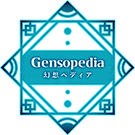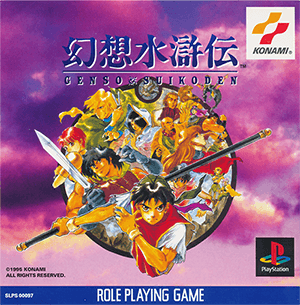Suikoden
More languages
More actions
Suikoden (幻想水滸伝, Gensōsuikoden), often referred to as Suikoden I, is the first instalment of the Suikoden series, designed and released initially for the Sony PlayStation and later for the Sega Saturn.
It tells the story of the (player named) son of Teo McDohl, general of the Scarlet Moon Empire and his exile from the Empire and rise to leader of the Toran Liberation Army aiming to overthrow the government.
Gameplay
As the first game in the series, Suikoden established many "series standards" many of which are used in the majority of games. The concept of the 108 Stars, and the ability to recruit them, in order to increase your forces and grow your base, has been in use in every mainstream Suikoden game to date, missing from only Suikoden Tactics and Gensosuikogaiden Vol.1 and Gensosuikogaiden Vol.2.
Suikoden's six-person party, arranged in two rows (front and back), which each character having an optimal range (Short, Medium or Long) was retained through Suikoden II and Suikoden III, was restored for Suikoden V and appeared in truncated form in Suikoden Tierkreis.
The use of personalised weapons for each character, sharpened by blacksmiths, rather than the traditional purchasing of new weapons, made it through all main Suikoden games, as well as Suikoden Tactics, until Suikoden Tierkreis dropped the concept. Equipping runes to grant magical powers as well as the use of "spell levels", rather than traditional MP, also lasted throughout the series until Suikoden Tierkreis moved to the more traditional MP system.
The first Suikoden game also introduced to the series war battles, as well as one-on-one duels. Again, both these ideas would be used in every main game of the series until 2009's Suikoden Tierkreis removed these regular parts of the series.
Plot Overview
The game told the story of the hero, the son of Teo McDohl, one of the Great Generals of the Scarlet Moon Empire. The hero, through his friend Ted, comes into possession of the Rune of Life and Death, one of 27 True Runes that governs various aspects of the world. The Rune, ruthlessly hunted for by corrupt officials within the Empire and their manipulators, forces the hero and his companions to flee the capital city of Gregminster.
Eventually, the hero finds his way to a rebel organisation where he is sheltered, although he is only convinced of the need to struggle against the Empire, when the hideout is attacked and sacked by Imperial forces. Recruiting the help of Mathiu Silverberg, a former Imperial strategist, McDohl's Liberation Army starts off as a small force working to unite rebel factions throughout Scarlet Moon before bringing down the Empire itself. Following the war, which was filled with much loss of life and many good people on both sides, the hero, still bearing the Rune of Life and Death, leaves the nation.
Releases
PlayStation
Suikoden was released on December 15, 1995 in Japan. It had two TV commercials in Japan, a 30-second spot and a shortened 15-second variant. The game would be released in North America on December 28, 1996, followed by a European release in March, 1997.
The game would be re-released twice on PlayStation in Japan. First on November 29, 1996 as part of the KONAMI the Best series, Konami's own re-release series, and again on July 11, 2002 as part of the PS one Books budget re-release series.
There were few strong differences between the Japanese and overseas versions of the game, save for dialogue adjustments for localization and such. The only major graphical change was a removal of the crossbeam and corresponding arm sprites where Sydonia and Varkas are tortured in Rockland. This would change the context of the scene from a crucifixion to being tied at the stake.
Saturn

The game would be ported to the Sega Saturn with a release date of September 17, 1997. Although the game was mostly identical to the PlayStation original, a number of additions were made. This version was never released outside Japan.
Graphically; portraits, spells, and other effects were redone for the Saturn's hardware. Though there is contention as to whether these are improvements or changes forced by Saturn hardware limitations. Gameplay wise, the major additions were an extra story event; at a certain point a random female recruit will be abducted by Anji and his crew and the player will have to rescue them. This would replace the original recruitment scenario for Anji, Kanak, and Leonardo.
Other additions included a coliseum mode run by Eikei, which included armor and equipment that was not part of the original PlayStation release, including the Darkness Rune. An additional short story scene was added after the revival of Gremio, showing his thoughts and experiences as he returned to life. A new opening movie was included, replacing the one on the original PlayStation.
Windows

On March 26, 1998, Suikoden received a port to the Microsoft Windows platform, specifically Windows 95. It was a full, dedicated port, utilizing a Windows-style GUI and tabs for menu navigation and presenting the game itself in a small window with menus on its right-hand side.
All menus were navigated using the mouse and through point-and-click. This included shops, equipment, runes, as well as battle options. Additional options allowed players to scale the size of the gameplay window to their preferance.
This release was only available in Japan, with no overseas versions available.
PlayStation Portable
- Main article: Gensosuikoden I&II
Suikoden would be ported, along with Suikoden II, to the Sony PSP on February 23, 2006 as part of Gensosuikoden I&II. The game would be adapted to display in the PSP's 30:17 screen ratio with minor graphical adjustments to accommodate the new resolution. A new portrait was also drawn for McDohl and ground textures in many locations were given more detail to match the aesthetic of Suikoden II slightly more closely. The game's content would remain identical to its original PlayStation release.
Mobile devices

On June 16, 2008, Suikoden would be ported to i-mode compatible mobile devices, available to download through the Konami Net DX mobile service. The game was over 19.4MB in size, thus requiring an SD card to download at the time. It cost 500 points on Konami Net DX, roughly working out to 525 Japanese yen.
The size of the in-game display would be truncated to fit within the restricted window size and ratio of mobile devices, forcing some sprite and portrait re-placement. The gameplay and content of the game remained unchanged from the original PlayStation version.
This version of Suikoden would be compatible with the i-mode version of Suikoden II released in 2009, allowing players to transfer their data in the same manner as the PlayStation original.
PlayStation Network
The original PlayStation version of the game would be the version ported to PSN on PlayStation 3 on December 23, 2008 and February 4, 2015 for North America and Europe respectively. Vita support in all regions would only be enabled on the game's release in Europe in 2015.
As Gensosuikoden I&II was already available as a digital title in Japanese PSN stores, Suikoden did not receive a Japanese release as a PS1 Classic title. This version of Suikoden is compatible with the PSN version of the Suikoden II, allowing players to transfer their data in the same manner as the PlayStation original.
Reception and legacy
Suikoden would earn a 26/40 score from Weekly Famitsu on its release, marking it as the lowest rated main game in the Suikoden series on original release by the magazine. The Saturn port of the same game would later receive a score of 25. This would stand unopposed as the lowest scored game in the series until 2001's Gensosuikoden Card Stories also earned a 25.

Coverage of the game overseas would begin in early 1996. As one of the PlayStation's earliest RPGs, it was the focus of great expectation and praise as well as a disproportionate amount of coverage compared to its sequels. GameFan would give an import version of the game scores of 90, 90, and 97 in its April 1996 issue. The game would be especially praised in these early stages for its deep story, variety of characters and gameplay, and its soundtrack.
Overseas reviews would begin to trickle out by the end of 1996. GameFan would give the English-language release scores of 90, 95, and 96. As before the story, gameplay, and music were highly praised with minor criticism coming into play for its burdensome equipment system and bland overworld map. Computer and Video Games gave Suikoden a score of 3/5 in January 1997, noting its graphical similarity to previous generation RPGs, but highlighting its strengths in story and music.
Other review outlets would follow much the same line. Edge UK would give the game 7/10, GamePro 4.5/5, PSExtreme 88%, and Next Generation 4/5. Electronic Gaming Monthly would give the game scores of 9.0, 9.0, 8.5, and 8.5 out of 10, earning the title an EGM Silver Award.
In November 1997, Sega Saturn Magazine mooted the possibility of a port of the Saturn version, noting its "improved graphics, revised game system, new maps and an original rendered movie". Nothing came of this. Over time the game would continue to be remembered fondly, even if crouched in qualifiers about the timeframe in which it was released. By 2002, it would be positively remembered as part of the series' PS1 duology. It would frequently be cited for comparison with its PS2 sequels, increasingly in a flattering fashion.
Media Adaptations
In April 1996, the Gensosuikoden Original Game Soundtrack was released as the game's official soundtrack. It came on 2 CDs and featured all 58 tracks featured in the game.
From August to November 2008, Assemble Gensosuikoden Radio! 108 Stars! was an internet radio show featuring an audio drama of the game performed by Japanese voice actors. These would be released as a drama CD on December 18, 2008.
Gensosuikoden The Succeed Crest was a manga adaptation of the game that ran for two volumes from 2009 to 2010. It is from that manga that we get the alternative name for the main character; Louie. Before that, the 1998 manga Parody Comic Series Gensosuikoden, focused exclusively on the title, being published before Suikoden II's release.





